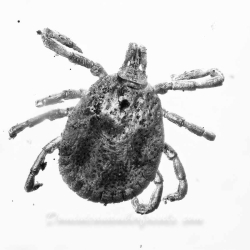- Description
- Specifications
Genuine Dominican Amber Fossil
Extremely Rare - Highly Collectible Inclusion
Live Arachnida Acarina Ixodidae (Hard Tick)
Amazing Specimen Very Well Displayed on Clear & Solid Amber Piece
A Must Have in all serious collection!!!
Contains a very nice "6" Shaped Larva as well as Several Other Specimens
32.0. x22.1 x 5.6mm - 2.20g
Ticks Description & Behavior
Ticks are small arachnids, belonging to the subclass Acari. Ticks are ectoparasites who live by feeding on the blood of mammals, birds and reptiles and are vectors of various diseases that affect humans and animals. Extant ticks are widely distributed around the world, especially in warm, humid climates. The two major families of Ticks are Ixodidae, or Hard Ticks, with more than 700 species and Argasidae or Soft Ticks, with 208 species.
Hard Ticks have a hard scutum, like a shield, on their dorsal surfaces. The scutum covers most of the dorsal surface of the male. It is much smaller in the female, allowing her to expand enormously as she feeds and becomes engorged with blood. The mouthparts of Hard Ticks have a beak-like structure, projecting forwards from the body, that can be seen from above.
Soft Ticks have a soft, wrinkled exoskeleton and their mouthparts, consisting of two palps and one hypostome, are located on the underside of the body and are not visible when viewed from above.
All Ticks have four life stages: Egg, Larva, Nymph and Adult.
Larval Ticks hatch with six legs and acquire the other two when, after a blood meal, they molt into the Nymph Stage.
In the Nymphal and Adult stages, Ticks have eight legs, each one has seven segments and is tipped with a pair of claws. Hard Ticks have only one Nymphal Stage. They stay attached to feed on their hosts for several days to weeks. Some species stay with the same host for life, but most Hard Ticks have two or three hosts.
In two-host case, Ticks Larvae and Nymphs feed and develop on the same host. Nymphs leave the host after the meal and develop into adults which will feed on a new host.
In three-host case, Tick each stage of life cycle feed on a different host species. In general the size of the host will increase with each feed as the size of the Tick increases.
Ixodidae usually mate while on host animals. After mating, blood-fed female adults drop from the host, lay a large mass of some thousand eggs in protected habitats on the ground and then die. The longevity of Hard Ticks ranges from a few months to 3 years.
Soft Ticks have various nymphal instars, each one requiring a blood meal from a host. They feed rapidly, usually for about 30 minutes at a time, so they don’t increase their weight as much as Hard Ticks do. After feeding Soft Ticks drop off the host and molt, consequently each meal takes place on a different host. The development stages of Soft Ticks last much longer than those of the Hard Ticks. Argasidae mate off the host. Adult females, after taking each blood meal, lay small batches of eggs several times during their lifetime. Soft Ticks can live up to 16 years.
Fossil Ticks are Extremely Rare in Dominican Amber
Only a few specimens of Hard Ticks of the genus Amblyomma (Acari Ixodidae) have been found and an unfed male has been described by Lane and Poinar (1986).
A blood-engorged nymphal female of the genus Amblyomma, surrounded by fossilized mammalian erythrocytes has been recently described by DR G. O. Poinard who speculates that the blood cells come from a monkey species (Journal of Medical Entomology, March 2017)
Soft Ticks are represented by a single new species: Ornithodoros antiquus ( Acari, Argasidae). Two unfed specimens, a male and a female have been described by DR G. O. Poinar (1994). In the amber piece containing the male is also present a dropping (scat) deposited by a rodent of the family Capromyidae, possibly the host of the Ornithodoros.











